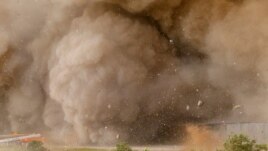30 April 2023
Last week's flight test of SpaceX's Starship spacecraft caused major damage to the launch structure in the state of Texas.
The day after the test, SpaceX chief Elon Musk said on Twitter the damage to the launch area was greater than expected.
Musk explained that the company had started work three months before on a large water-cooled steel plate to be placed underneath the concrete launch pad. The structure is meant to protect the concrete pad, the rocket's support structure, from being damaged from the heat and force of the rocket's engines.

Rocks and other debris fly around remote cameras as SpaceX's next-generation Starship spacecraft atop the Super Heavy rocket lifts off from the company's Boca Chica launchpad near Brownsville, Texas, U.S. April 20, 2023. (REUTERS/Joe Skipper/File)
But Musk added that the steel plate would not have been ready before the launch date on April 20. He said SpaceX "wrongly thought" the concrete launch pad would survive the liftoff because it had survived an earlier test.
He suggested that the steel plate could be ready for a new launch attempt "in 1 to 2 months." But it is currently not clear when the next Starship test will be approved. The Federal Aviation Administration (FAA) has said it will have to carry out an investigation of the launch site damage before it can approve a new test.
Pictures published on social media have shown large pieces of concrete being pushed deeply into the ground. Video of the launch showed pieces of debris being thrown up to 420 meters away. The launch also reportedly created several large craters around the area.
The test involved SpaceX's Super Heavy rocket, which carries the Starship capsule on top. The capsule is designed to carry astronauts and supplies to the moon and possibly to Mars. The Super Heavy rocket is powered by 33 engines and is by far more powerful than any rockets built by the American space agency NASA.
The two-part rocket ship successfully launched from the SpaceX launch center, called Starbase, in Boca Chica, Texas. But it exploded minutes later and crashed into the sea.
SpaceX had hoped that, after separating, the spacecraft would continue flying and attempt to circle the world before crashing into the Pacific Ocean near Hawaii. But even with the explosion, the company has described the flight test as a success because the huge rocket was able to get off the ground.
Other launch sites in the United States use long diverters in the ground to guide fire away from the rockets. The diverters are designed to limit damage from launches. The launch area that SpaceX uses at NASA's Kennedy Space Center in Florida has diverters.
Without diverters, debris thrown into the air during liftoff could strike the rocket itself and nearby areas, engineers say.
Phil Metzger is a planetary scientist at the University of Central Florida who has studied the effects of rocket launches and landings. He said on Twitter, "Launch & landing pads are touchy. Any little thing that goes wrong can cause a zipper effect that creates a giant problem."
Metzger said such difficulties can result because the energy used to push the rocket into space needs to be absorbed on the ground.
Observers say the incident demonstrates a certain rocket development culture at SpaceX. That culture favors more tests and failures of new vehicles to provide data to improve future designs.
Tom Marotta advises other space companies on launch rules. He told Reuters news agency the FAA oversees launch safety and carries out technical investigations into rocket failures. He said the agency will need to approve changes to Starship's launch area before any new launch attempts.
Marotta added that "the bigger challenge" for SpaceX will be getting the FAA to examine its steel plate in order to approve another launch test in the coming months.
The FAA has confirmed that no injuries resulted from the launch test, the French news agency AFP reported. But it has also said that no new tests will be approved if there is a threat to public safety.
Olivier de Weck is a professor of astronautics and engineering at the Massachusetts Institute of Technology (MIT). He told AFP he agrees with SpaceX that the test was "more a success than a failure."
He said the reason the company has made such great progress in recent years "is because they are willing to take risks and break things." De Weck added, "But they learn from it, and improve very, very quickly."
I'm Bryan Lynn.
Bryan Lynn wrote this story for VOA Learning English, based on reports from Agence France-Presse, Reuters and SpaceX.
_______________________________________________________
Words in This Story
plate – n. a flat piece of metal or glass
debris – n. broken pieces of something
capsule – n. the part of a spacecraft that people ride in
divert – v. send something somewhere different than expected
zipper – n. a connector made up of metal or plastic teeth or strips that permit the opening and closing of something
absorb – v. to take in a substance
challenge – n. something difficult that tests someone's ability or determination